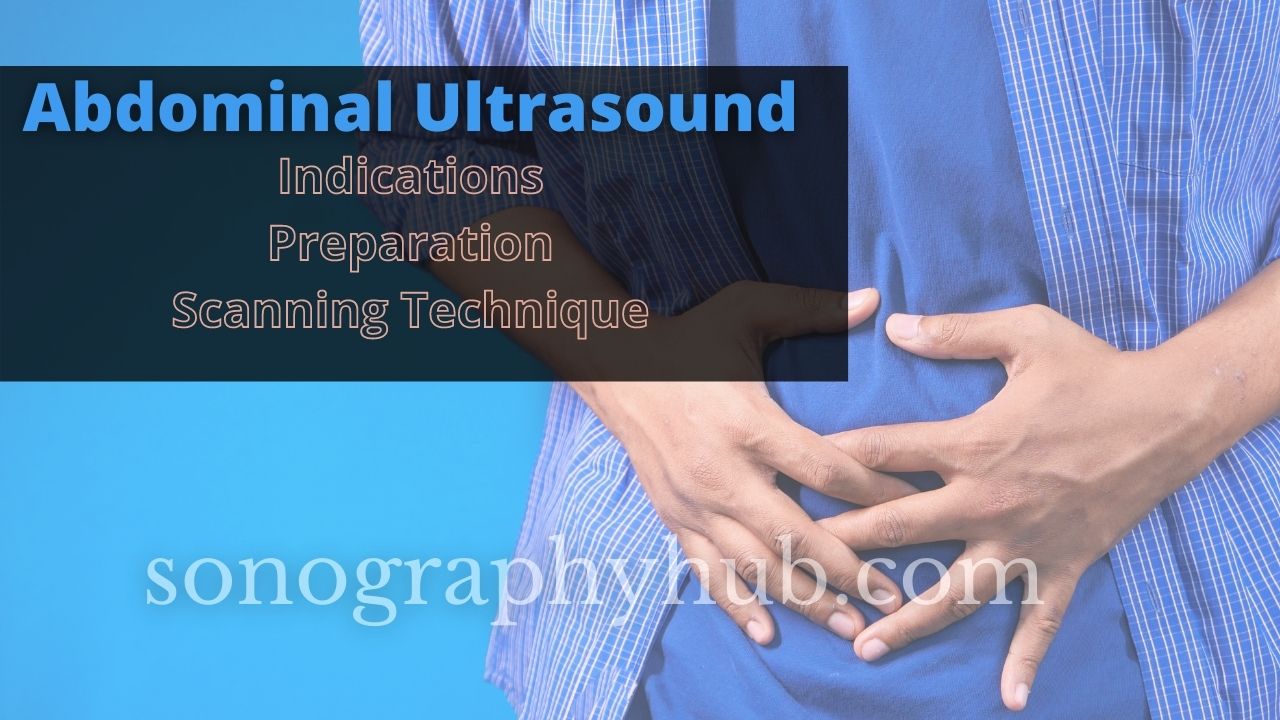The sonographer (technician) gently presses the transducer against the stomach area, moving it back and forth. The device sends signals to a computer, which creates images that show how blood flows through the structures in the abdomen. A typical ultrasound exam takes about 30 minutes to complete.
 |
| Abdominal Ultrasound |
What are the indications for the general abdominal ultrasound?
When the clinical symptoms indicate a particular organ, refer to the appropriate section, e.g. liver, spleen, aorta, pancreas, kidney, etc.
Indications for general abdominal ultrasound scan:
- Localized abdominal pain with indefinite clinical features.
- Suspected intra-abdominal abscess. pyrexia of unknown origin.
- Nonspecific abdominal mass.
- Suspected intra-abdominal fluid (ascites).
- Abdominal trauma.
Preparation for abdominal ultrasound
Preparation of the patient during an abdominal ultrasound:
The patient should take nothing by mouth for 8 hours preceding the examination. If the fluid is essential to prevent dehydration, only water should be given. If the symptoms are acute, proceed with the examination. Infants - clinical condition permitting- should be given nothing by mouth for 3 hours preceding the examination.
Position of the patient during an abdominal ultrasound
The patient should lie comfortably on his/her back (supine).
The head may rest on a small pillow and, if there is much abdominal tenderness, a pillow may also be placed under the patient's knees.
Cover the abdomen with the coupling agent.
The patient can be allowed to breathe quietly, but when a specific organ is to be examined, the patient should hold the breath in.
Choice of a transducer for the abdominal scan
Use a 3.5 MHz transducer for adults.
Use a 5MHz transducer for children or for thin adults.
Curvilinear or sector transducers are preferable when available.
Setting the correct gain for the abdominal scan
Start by placing the transducer centrally at the top of the abdomen (the xiphoid angle) and ask the patient to take a deep breath and hold it in.
Angle the transducer beam towards the right side of the patient to image the liver. Adjust the gain setting so that the image has normal homogeneity and texture. It should be possible to recognize the strongly reflecting lines of the diaphragm next to the posterior part of the liver.
The portal and hepatic veins should be visible as tubular structures with an echo-free lumen. The border of the portal veins will have bright echoes, but the hepatic veins will not have such bright borders.
Scanning technique for abdominal ultrasound
After adjusting the gain, slowly move the transducer from the midline across the abdomen to the right, stopping to check the image approximately every 1 cm. Repeat at different levels. When the right side has been scanned, examine the left side in the same way. The transducer can be angled in different directions during this process to provide more information and better localization. It is important to scan the whole abdomen. if, after angling the beam, the upper parts of the liver or spleen are not seen, scanning between the ribs may be necessary.
After the transverse scans, turn the transducer 90degree and start again centrally at the xiphoid angle below the ribs. Again, locate the liver and, if necessary, ask the patient to take a very deep breath to show it more clearly. Make sure that the gain settings are correct. When necessary, angle the transducer towards the patient's head (cephalad). Scan between the ribs to visualize better the liver and the spleen.
Below the ribs, keep the transducer in a vertical position, and move it downwards towards the feet (caudad). Repeat in different vertical planes to scan the whole abdomen.
If any part of the abdomen is not well seen with the transducer, the patient may be scanned while sitting or standing erect. If necessary, scan in the lateral decubitus position: this is particularly useful for imaging the kidney or spleen. Do not hesitate to turn patient. Whenever there is any suspected abnormality use the technique described in the appropriate section.
It is important to recognize during the abdominal scan
Aorta and inferior vena cava.
Liver, portal vein, hepatic vein.
Biliary tract and gallbladder.
Spleen.
Pancreas.
Kidneys.
Diaphragm
Urinary bladder (if filled).
Pelvic contents.

Post a Comment